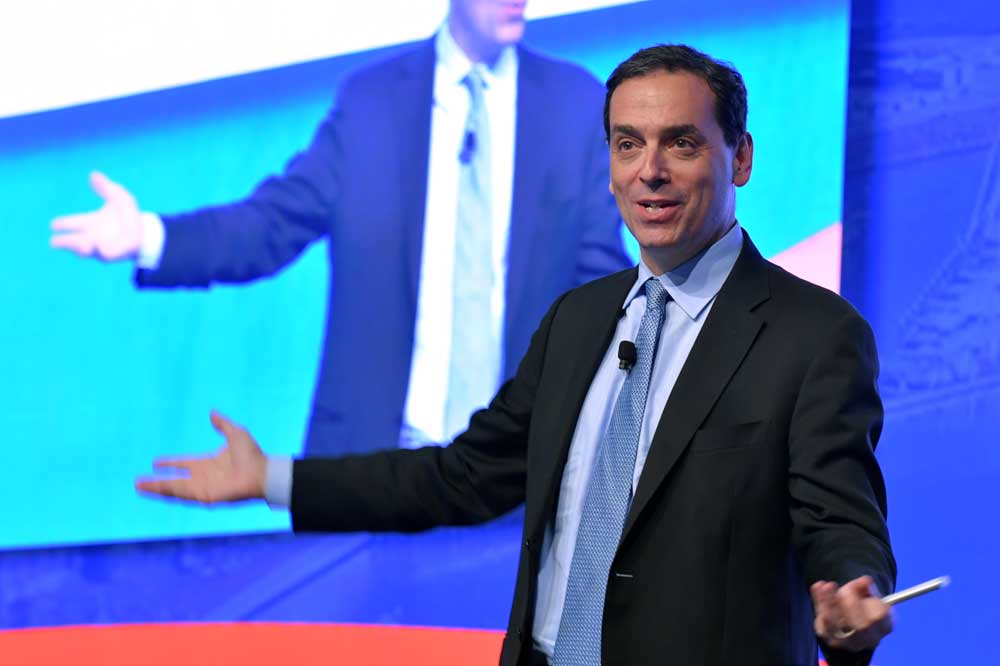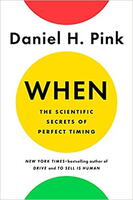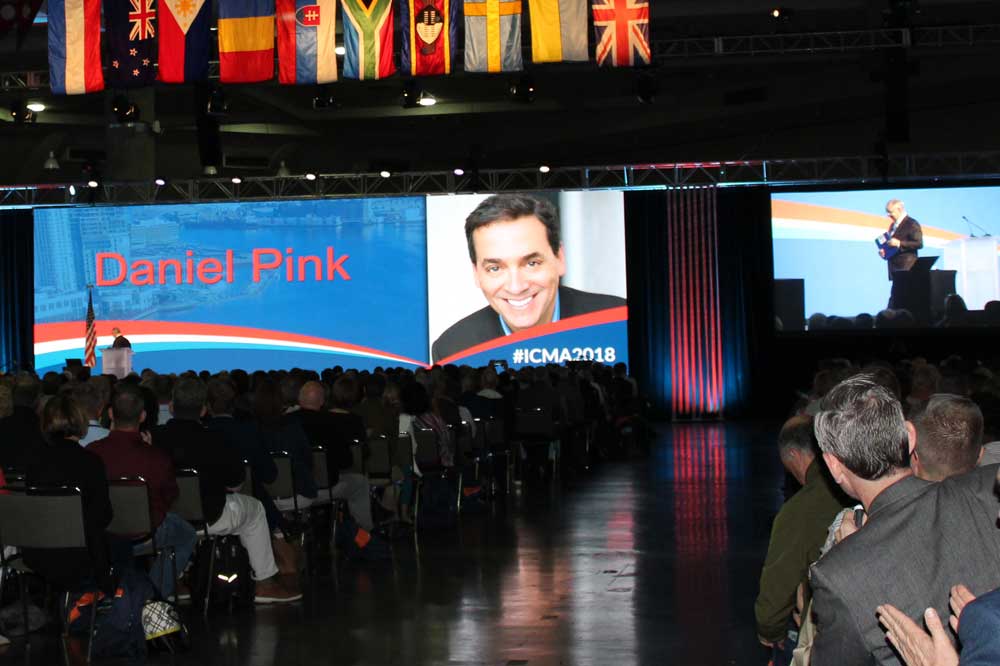
PM Magazine, January/February 2019
Knowing that Daniel Pink’s keynote presentation at ICMA’s Annual Conference in September 2018, “The Scientific Secrets of Perfect Timing,” was so well received by ICMA members in attendance, PM magazine asked him to share his research and findings on the importance of timing in a person’s life, which is the subject of his latest bestselling book When: The Scientific Secrets of Perfect Timing.
PM magazine: In your book, you emphasize that the time of day someone does things may be one of the most important factors to consider in how people perform on the job. What are some ways that local government managers can apply this wisdom when leading staff members?

In particular, most of us move through the day in three stages: a peak, a trough, and a recovery. During the peak, we should be doing analytic work—work that requires head-down focus and attention. Think writing a report or crunching numbers. During the trough, we should be doing administrative work—work that doesn’t require intense analysis or creativity. Think answering routine e-mails. During the recovery, we should be doing insight work—work that benefits from being a little mentally loose and creative. Think brainstorming.
Most of us move through the day in this order: peak in the morning, trough in the early to midafternoon, and recovery in the late afternoon and early evening. But about 20 percent of us—people who have “evening chronotypes”—don’t follow this pattern. Night owls tend to reach their peak late in the afternoon and into the evening. If managers can get people doing the right work at the right time, they’ll see better performance and higher satisfaction.
PM: On a larger scale, how can local government managers use these principles to help make life better for the residents they serve?
DP: The science of timing isn’t only about what happens over the course of a day. Another dimension is understanding how much of our lives are episodic. Most of our experiences—from projects to careers to relationships—have beginnings, middles, and ends. And each of these stages exerts a different influence on our behavior.
So, when thinking of residents’ encounters with government, including everything from a visit to the department of motor vehicles, a public park, or the mayoral town hall, keep this in mind: Being intentional about beginnings, midpoints, and endings can make a world of difference. For instance, the science shows that endings have a profound effect on both motivation and memory. Raising the salience of an ending can get people to move. So if you’re setting deadlines for residents, shorter deadlines, which might seem unfriendly, are often more effective than longer ones. Local government managers should also remember that how an encounter ends hugely affects how people encode it. So being deliberate about ending encounters with city hall on a positive note can shape how people view government services.
PM: How would you suggest managers help elected officials think about the importance of timing? Is the importance of timing as crucial as getting policy recommendations correct?
DP: Getting the timing right on policies isn’t more important than the policies themselves. But smart officials should factor it in. For instance, certain dates operate as what researchers call “temporal landmarks.” They stand out in time the way physical landmarks stand out in space. They get us to slow down—and then to perform a peculiar kind of mental accounting.
On these “fresh start dates,” we relegate our old imperfect selves to the past and open up a fresh ledger on our new better selves. This is why you’re more likely to start—to be successful in sustaining—a new diet, exercise plan, or work approach if you start it on a Monday rather than a Thursday, the first of the month rather than the 13th of the month, or on the day after your birthday rather than the day before your birthday. If officials want to change resident behavior, launching a new policy on a fresh start date might give them a better chance at having the behavior begin and eventually stick.

PM: Your research is persuasive on the importance of mentally restful breaks. How do local government professionals create this type of culture in a fish bowl where rest may be perceived as waste?
DP: That’s a good point. We still have a bias against breaks. But in my view, the science of breaks is where the science of sleep was a decade ago—about to break through the surface and recalibrate our understanding of what it takes to be effective.
There are two key insights from the research. First, breaks are not a deviation from high performance. They’re part of high performance. Breaks are what professionals do. Only amateurs look down on breaks. Second, we know a lot about the sorts of breaks that are best at restoring mood and boosting productivity. We know that breaks when we move—say, talking a walk—are more restorative than those when we’re not moving. Breaks in nature, like simply going outside, are especially powerful. And there’s a bunch of research that shows that breaks are more effective when we’re fully detached—not semidetached.
So, I wouldn’t advocate that everyone in local government take a daily nap. But I would argue that if every local official took a 15-minute walk break each afternoon, taxpayers would benefit.
PM: The magazine is celebrating its 100th year, and ICMA is turning 105, in 2019. What should we take from such an enduring legacy?
DP: You’re doing something right! What’s more, it shows that government managers always want to know about best practices and how to do their jobs well. If some of this science of timing can help them, then all the better!
PM: What are some issues to keep in mind as PM, and the local government profession, look toward the next 100 years?
DP: I don’t know about the next 100 years, but over the next 10 or 15 years it seems like three issues will move to the front burner. One is inequality—particularly, the growing sense that the 21st century economy is leaving many people behind.
Second is reckoning with what could be a substantial increase step change in machine and software intelligence. That will produce many opportunities for local government to do its job better; however, of course, it could also create other upheavals for officials.
Third, especially here in the United States, is political polarization and its effect on local governance. What will be the balance of power and responsibility between federal and local government and between state and local governments when Americans are becoming much more politically segregated?
PM: Is there any other message that you’d like local government managers to consider and apply to their workday and to their personal lives?
DP: Two of them. First, be much more strategic about scheduling meetings. People spend a huge amount of time in meetings. But the only criterion organizations use in scheduling them is availability. That’s a big mistake. Figure out what kind of meeting it is: Do the people attending need to be locked down and analytical? More open and freewheeling? Or is the meeting purely administrative? And who’s going to be there? Larks, owls, or a mix? The “when” of meetings isn’t a purely logistical decision. It’s also a strategic one. Second, as we discussed before, take more breaks and take the right kinds of breaks.
PM: While you were at the ICMA conference in September, were you able to talk one-to-one with managers and, if so, what concerns did they raise with you?
DP: Several people wanted to know how to figure out someone’s chronotype—that is, whether they’re a lark or an owl. There are two instruments (questionnaires) that they can find online: The Munich Chronotype Questionnaire (MCTQ) and the Morning-Eveningness Questionnaire (MEQ). There’s also a back-of-the-envelope method. It begins by thinking of what chronobiologists call a “free day.” A day when you don’t have to wake up to an alarm clock and can go to sleep and wake up whenever your body tells you.
First, think about what time you’d go to sleep on one of those free days. Second, think about what time you’d wake up. Third, figure out the midpoint of your sleep. If the midpoint is before 3:30 a.m., you’re probably a lark. If it’s after 5:30 a.m., you’re probably an owl. And if it’s in-between 3:30 a.m. and 5:30 a.m., you’re probably in the middle, and what I call “third bird.” So, for me, I’d typically go to sleep at midnight and wake up at 8 a.m., making my midpoint of sleep 4 a.m. and identifying me as a third bird.
PM: What is one time-saving (or “aid-to-better-time-spent”) app or hack you would recommend to students and early careerists?
DP: Each morning, take care of one extremely important task before answering e-mail. Responding to e-mail first thing in the morning is one of the most productivity-destroying things white collar workers do.

New, Reduced Membership Dues
A new, reduced dues rate is available for CAOs/ACAOs, along with additional discounts for those in smaller communities, has been implemented. Learn more and be sure to join or renew today!
